Toasted coconut rum cake is a tropical favorite with a twist! This tender and moist rum cake from scratch has a lovely coconut flavor thanks to coconut milk and coconut rum. It’s a great make-ahead boozy cake for a party, and if made in loaves, freezes beautifully for later!
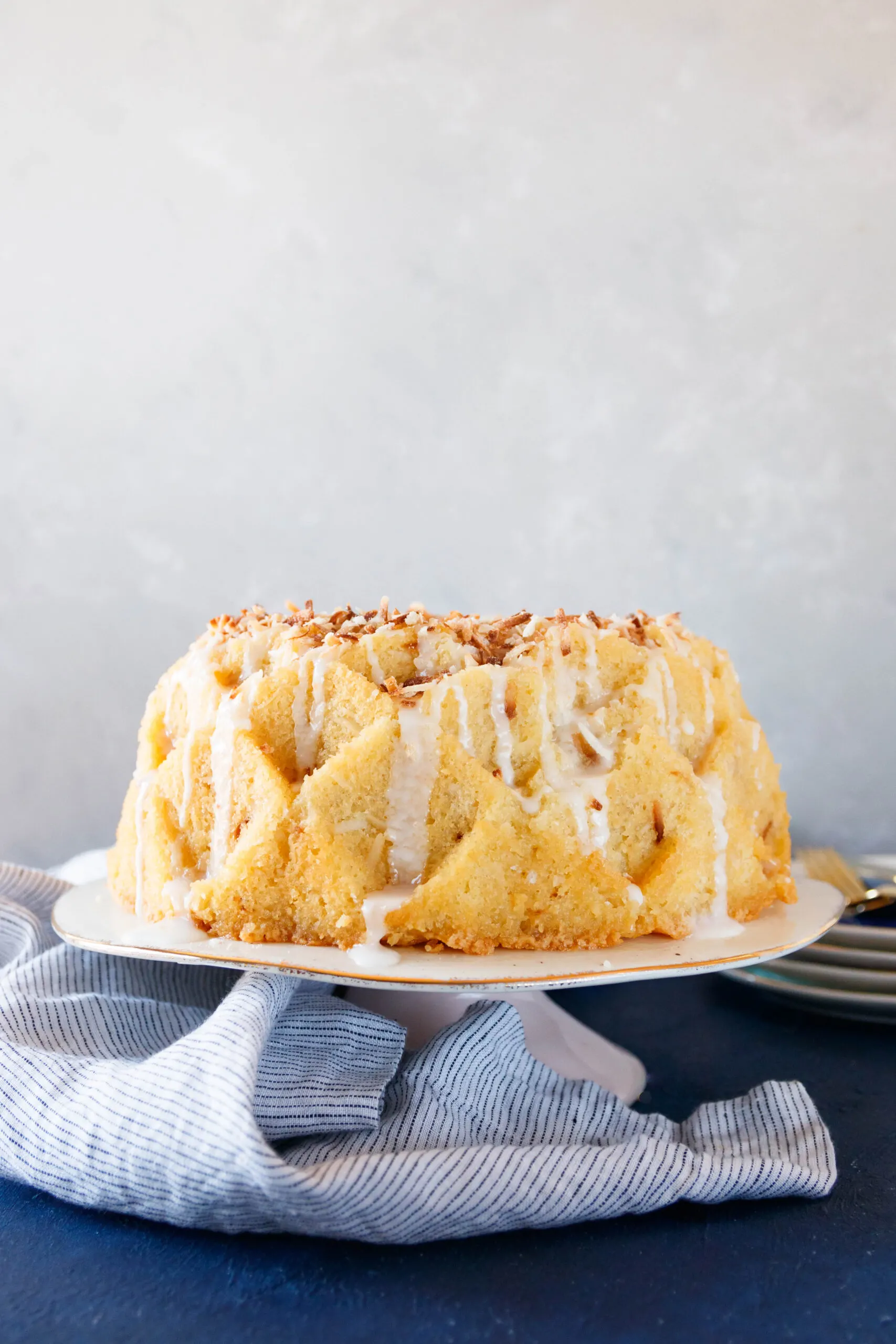
A good rum cake recipe is a treasure, darlings. Balanced, sweet without being cloying, and flavored with just the right amount of rum to have a little kick. When you find one, you save it and use it. This is why you haven’t seen a rum cake on the blog since I posted my Better Than Tortuga Rum cake. We had no need, until now. Now, we have another tasty cake to add to our repertoire in this toasted coconut rum cake.
What is rum cake?
Rum cakes are very popular in Caribbean countries, where rum is produced. The rum cake base is a vanilla or chocolate butter cake that is soaked with a rum glaze while still warm. They are made in a variety of different shapes. The most common are bundt, loaf pans, or sheet cakes.
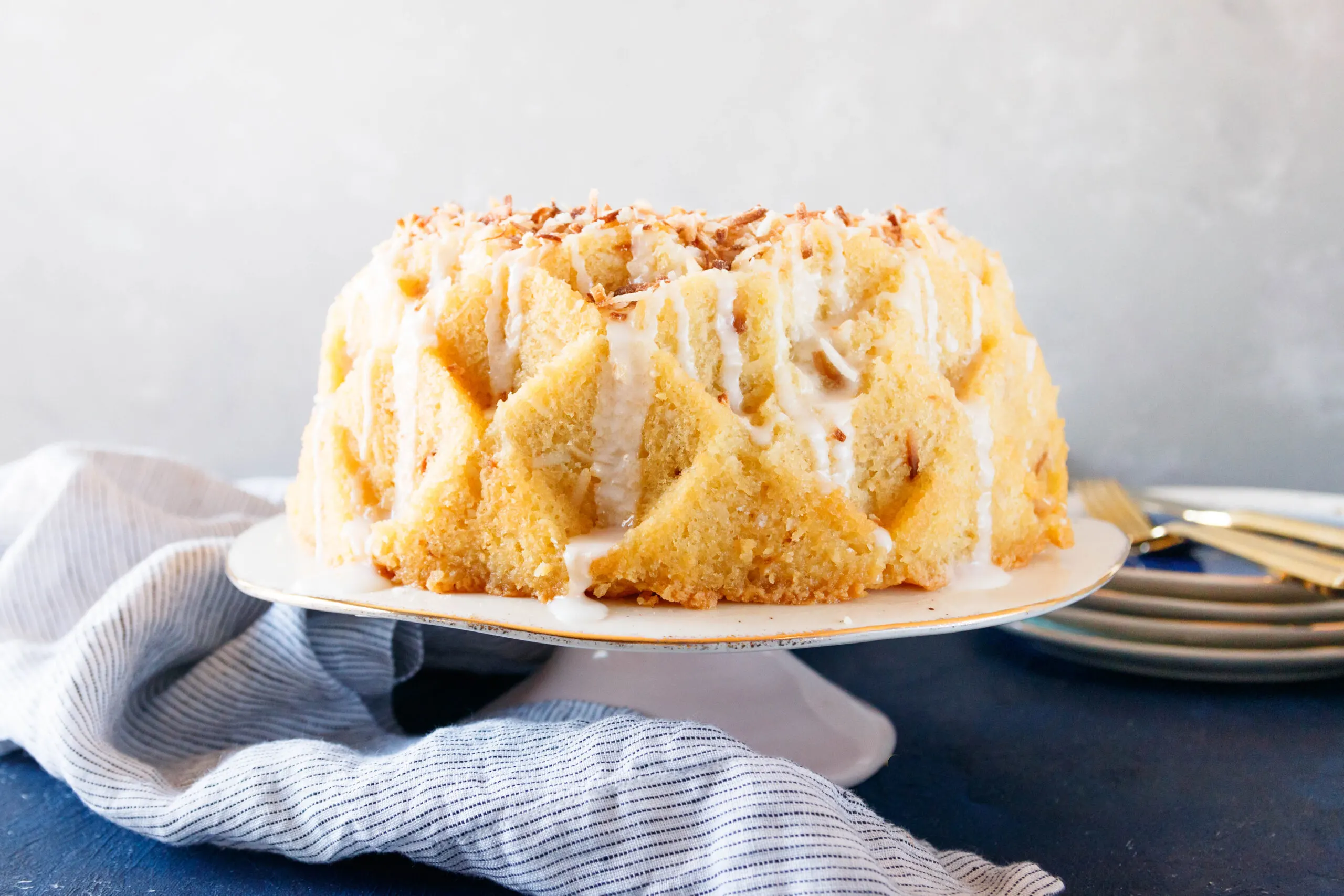
While the cake is still warm, a sugar and rum glaze is poured over the cake. The glaze soaks through providing both moisture and flavor. Most rum cakes are unfrosted, especially in loaf and bundt form. Sometimes, bakers will frost rum cakes with stabilized whipped cream if they desire.
The cakes are soaked in alcohol. Most recipes, including this one, don’t have enough rum to make you inebriated. You’ll get a stomachache from too much cake first! Use your best judgment on who may partake depending on how liberally you interpret the rum measurements for the glaze in the recipe.
What gives this toasted coconut rum cake coconut flavor?
To really infuse the coconut flavor into the cake, we add coconut in both the batter and the glaze. The cake is made with coconut milk – the canned kind – and coconut rum.
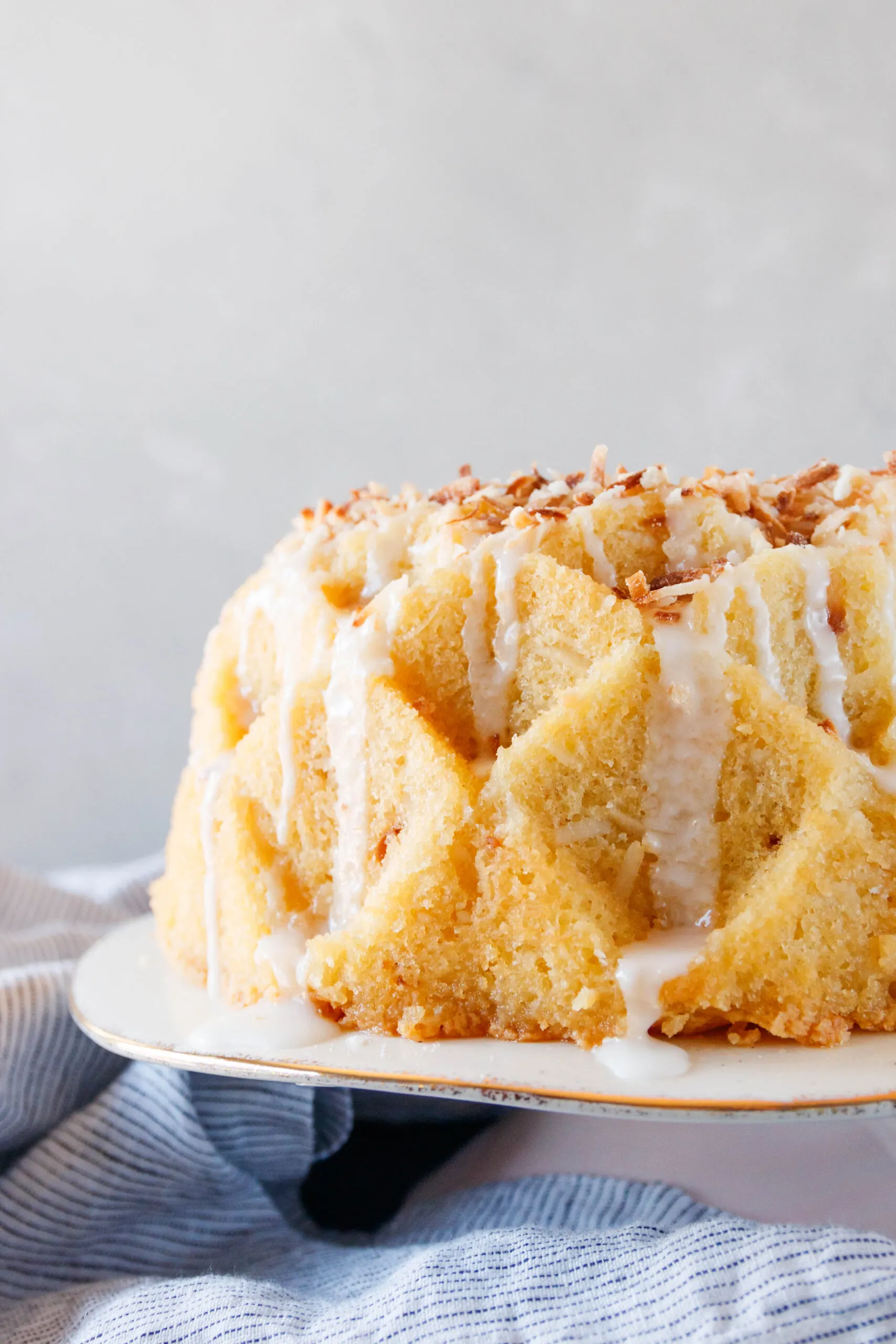
If you want to make this coconut rum cake dairy-free, swap out the butter for a plant-based alternative. Then, don’t use sour cream and regular coconut milk. Look for a can of coconut cream, unsweetened, and use that instead of sour cream and coconut milk. No one will ever know the swap, and you’ll get an extra natural coconut flavor boost!
The one thing I don’t use in the cake itself most of the time is shredded coconut. You can add some in the batter if you’d like, but not everyone is a fan of the texture. Flakes work better than shreds.
When I only have shredded coconut on hand, I stick to coating the top of the cake with toasted coconut. If I have flaked coconut, I’ll add about a 1/2 cup of toasted flaked coconut to the batter.
Glaze adjustments based on cake shape…
The basic glaze recipe remains the same regardless of the cake shape. Buuuuuuuttttt, I have some notes on how to best distribute the glaze depending on cake shape. Those of you who tend to be a little heavy-handed with the rum pours, this is your section.
Bundt cakes, while my personal favorite for rum cake shaping because they’re pretty, are the trickiest when it comes to glazing. The cake is thick, so you’ll want to pour part of the rum glaze over the cake while it’s inverted, and then the rest over the cake once it’s been flipped out of the pan. As you can imagine, this does make flipping a touch trickier.
Start by poking a few holes in the inverted cake, then pour between 1/3-1/2 of the glaze into your bundt pan, slowly. Allow the cake to rest a few minutes, then invert. Or use whatever flipping mechanism works for you to release bundt pans. Everyone has their favorite trick.
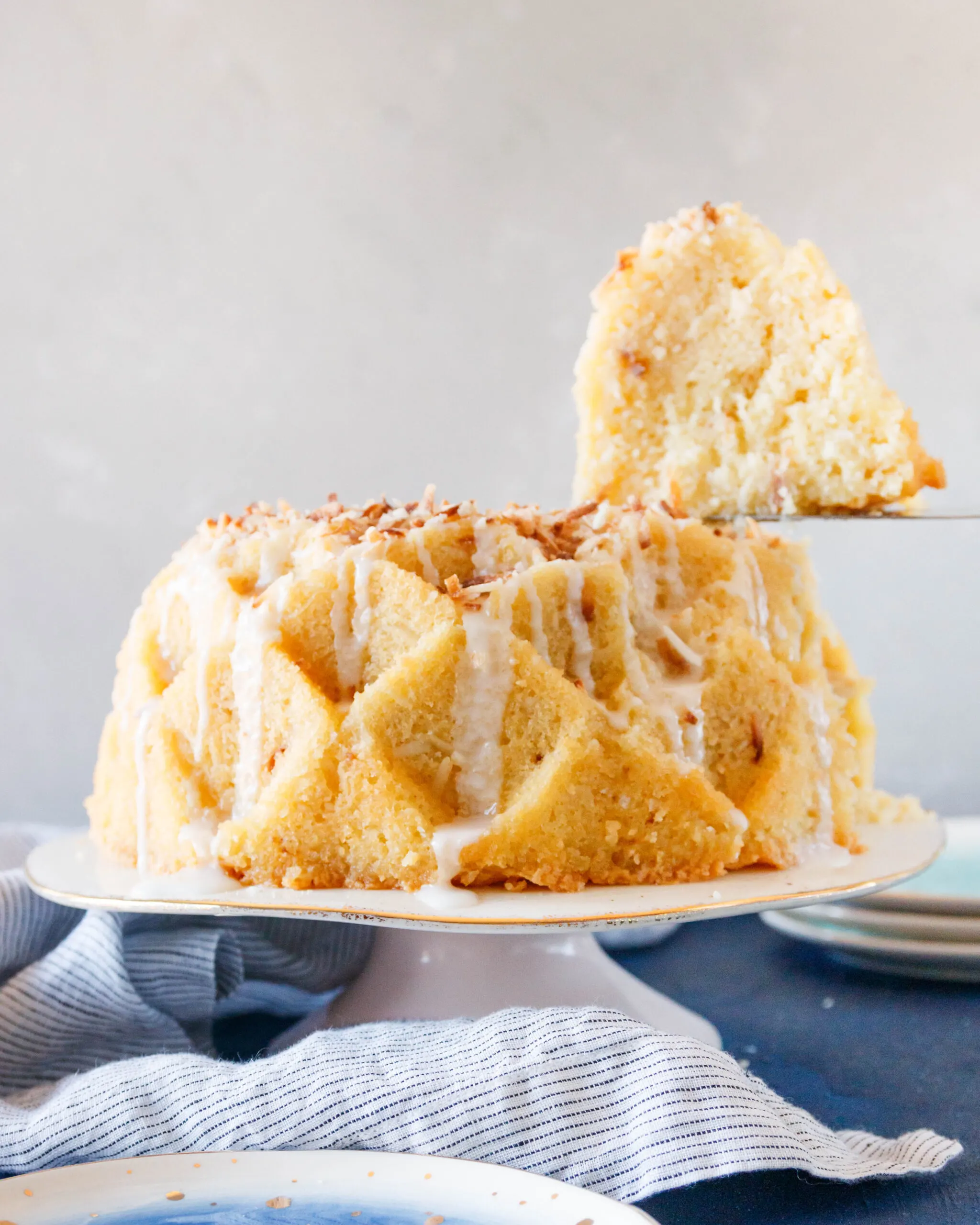
Once the cake is inverted, place it over a rack, poke a few more holes in the cake. Slowly pour the rest of the glaze over the cake. You may want to work on a cooling rack placed over a rimmed baking sheet as you’ll spill a little. I usually flip my bundt pan onto a cake board that’s about the same diameter as the cake. That makes soaking and transferring to the final cake plate easier.
If your rum bundt cake falls apart, don’t fret! I’ve never heard complaints, and you can always make a tasty rum trifle. Or make these pineapple cheesecake shooters and replace the crust layer with rum cake. You’re welcome.
Loaf pans are more forgiving than bundt cakes because there’s no flipping involved! You can easily add more rum here for more soak if the loaves will cool in the pan. Just know that if you’re baking in paper loaf pans – like for gifting – look for pans that have a bit of a protective layer lining the inside. It keeps your packaging from falling apart.
If you want to bake a really boozy toasted coconut rum cake for adults only…
Bake this as a 9×13-inch sheet cake. Then rum amounts are really open to interpretation! I worked with someone once whose wife would use the entire 750 mL bottle between the cake and the glaze when she made a rum sheet cake. Then it’s definitely a dessert for the 21+ crowd!
If you go this route, add a whipped topping. The whipped topping from my tres leches cake is perfect. You want to balance the bite from the booze with a creamy topping. Not only will bites be better balanced, but the whipped topping is a lovely backdrop for toasted coconut topping!
You cannot be nearly as heavy-handed with any of the other cake shapes because the cake will not hold its shape! The sheet pan really helps. I also serve this version chilled because of the whipped topping.
A few final recipe notes…
A rum cake that doesn’t have a whipped topping can be kept at room temperature up to 3 days. Refrigerate for up to a week, or freeze for 3 months. Loaf-shaped cakes in their pans freeze best, in my opinion since they are the easiest to wrap.
If you don’t have cake flour, make your own! Just measure out one cup of all-purpose flour into a bowl. Remove 2 tablespoons. Add 2 tablespoons of cornstarch and whisk very well to combine. That’s it! All you’re doing is lowering the overall protein content of the flour in the recipe. This creates a lighter crumb that makes a better base for the rum.
There are so many coconut milk options available! You find coconut milk in the non-dairy refrigerated section and in cans on the shelf. The best coconut milk to use for this recipe is the canned coconut milk. It’s thicker, and that richness gives the cake more flavor. Just be sure to shake the can very well to mix the water and cream before you open it.
Be careful not to pick up “cream of coconut” which is a sweetened coconut milk mixture used in cocktails and other desserts. This will be too sweet for your cake!
As for the coconut rum, buy your favorite brand! Today I used Malibu black, the higher proof rum. Incidentally, this is also the only coconut rum you can use if you want to make a coconut rum vanilla extract. The others don’t have a high enough proof to be safe for extract making.
Knowledge is power, darlings.

I hope you love this toasted coconut rum cake recipe. Happy baking!
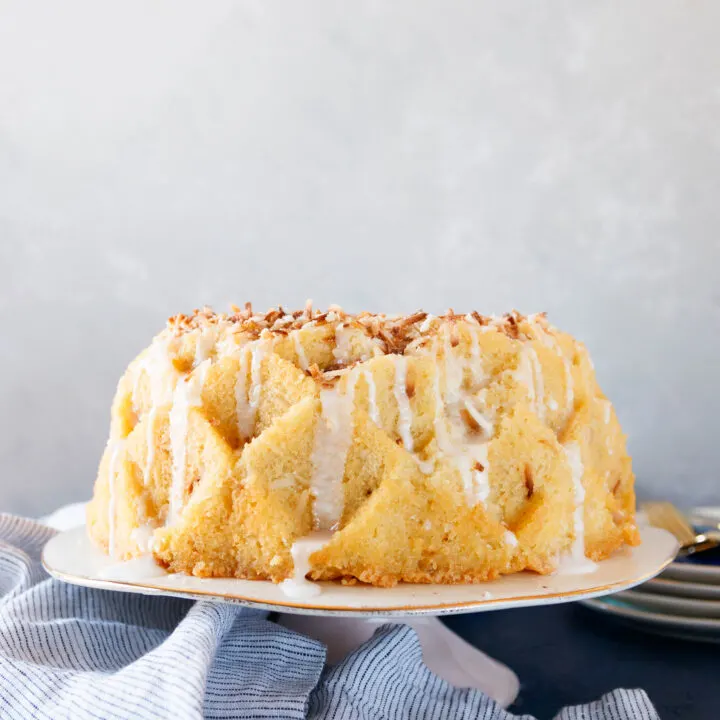
Toasted Coconut Rum Cake
Toasted coconut rum cake is a tropical favorite with a twist! This tender and moist rum cake from scratch has a lovely coconut flavor thanks to coconut milk and coconut rum. It's a great make-ahead boozy cake for a party, and if made in loaves, freezes beautifully for later!
Ingredients
Cake Batter
- 2 cups cake flour (see notes)
- 1 1/2 cups granulated sugar
- 4 tsp baking powder
- 1 tsp salt
- 1/2 cup unsalted butter, cut into tablespoons
- 1/4 cup sour cream
- 3/4 cup coconut milk (see notes)
- 4 large eggs
- 2/3 cup coconut rum
- 1/2 cup oil
Rum Soaking Glaze
- 1⁄2 cup butter (1 stick)
- 1⁄4 cup water
- 1 cup granulated sugar
- 1 cup coconut rum rum
Coconut Topping:
- 1 cup shredded or flaked coconut (sweetened or unsweetened), see notes
Optional Glaze:
- 2/3 cup powdered sugar
- 3-5 teaspoons coconut rum, milk, or water
Optional Whipped Topping:
- 1 1/2 cups heavy whipping cream, chilled
- 1 1/2 tablespoons powdered sugar
- 1 teaspoon vanilla extract or coconut extract
Instructions
- Toast your coconut flakes by placing your desired amount in an ungreased skillet over medium-low heat. Stir frequently for about 5 minutes until the flakes look golden brown. Immediately transfer the coconut to a plate or other surface to cool. The coconut will become a bit crunchy as it cools. Set aside
- Preheat your oven to 325 F. Butter and flour a 12-cup bundt cake pan, 2 9x5-inch loaf pans, or one 9x13" casserole dish. Set aside.
- Place the flour, sugar, baking powder, salt, cut butter, and vegetable oil into a stand mixer fitted with a paddle attachment or into a large mixing bowl to use a hand mixer.
- At low speed, combine the ingredients until the mixture resembles coarse wet sand.
- Stir in the eggs, one at a time. Scrape the sides of the bowl after each addition.
- Add the sour cream, coconut milk, and rum. Stir until just combined.
- Pour the batter into the prepared cake pan(s) and bake for 50-60 minutes (for a bundt cake) until a tester comes out clean. If baking in loaf pans or as a sheet cake, the baking time is closer to 35-45 minutes since the cake is not as thick.
- Remove from the oven and place on a rack. Prepare the rum-soaking glaze.
- In a saucepan over medium heat, melt the butter, water, and sugar together. Stir and cook until the sugar is dissolved. Continue to cook for 4-5 minutes until the syrup thickens slightly, stirring frequently.
- Remove the syrup from the heat and stir in the coconut rum.
- Use a skewer to poke holes all over the top of the still-warm cake. Slowly drizzle the rum glaze over the cake.
- Allow the cake to cool completely before topping it with the optional glaze or whipped cream and toasted coconut and serving.
- To make the glaze, sift the powdered sugar into a bowl. Add 2 teaspoons of your preferred liquid, then keep adding, a teaspoon at a time, until the mixture is thick but pourable. Drizzle over the cake.
- To make a whipped topping, place the chilled cream, sugar, and extract in a cold mixing bowl (if using a hand mixer) or the bowl of a stand mixer fitted with the whisk attachment. Start whisking at low speed and work your way up to high speed. Stop whipping as soon as stiff peaks form. Spread the whipped cream over the completely cooled cake.
- Cake may be made up to 2 days in advance (it's better after an overnight rest!) and refrigerated. Leftover cake can be refrigerated for up to a week or double-wrapped and frozen for up to 3 months.
Notes
- If you don't have cake flour on hand, an easy substitute is 1 3/4 cups all-purpose flour and 1/4 cup cornstarch. Sift together twice to combine well.
- For the best results, use canned coconut milk instead of refrigerated coconut milk. Shake the can well before opening it. The coconut milk in the can is richer, so adds more flavor and moisture to the cake.
- If you'd like to add flaked or shredded coconut to the cake batter, increase the amount of coconut to 1 1/2 cups. Toast and cool the coconut before you start mixing your batter. If you are just using the coconut as a topping, you may toast it while the cake is baking or cooling. If you want crunch in your coconut, don't add it until just before you serve the cake.
- When glazing a bundt cake, I pour between 1/3 and 1/2 of the glaze over the cake while it is still in the pan. Then I invert the cake and top with the rest of the glaze.
Recommended Products
As an Amazon Associate and member of other affiliate programs, I earn from qualifying purchases.




